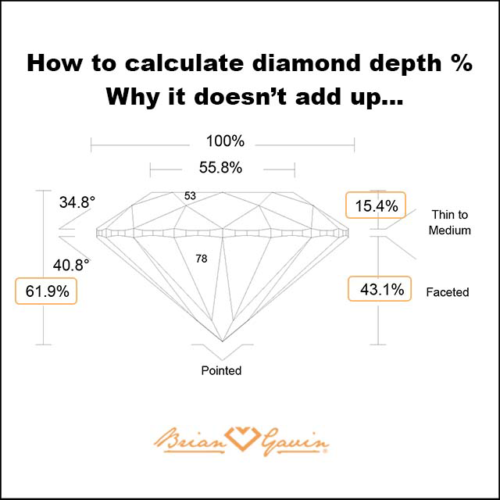
Expert Guide: How to calculate diamond depth percentage
“I’m wondering whether you can tell me how to calculate diamond depth percentage. The reason I ask is because I’m looking at this 1.348 carat, G-color, VS-1 clarity, Black by Brian Gavin Signature round diamond (amongst others) and I just can’t figure out how the parts add up to the total depth of 61.9%. I don’t understand how the gemological laboratories do the math, but when I add up the pavilion depth of 43.1% (lower half) + 15.4% crown height (upper half) I come up with 58.5% which is a long way from the 61.9% total depth stated on the lab report. What am I missing?”
Understanding diamond total depth:
The missing part of the equation as outlined above, is the girdle thickness. It’s going to be up to 3.3% for a medium girdle on the AGS system. With that in mind, add up 43.1 + 15.4 + 3.3 and you get 61.8% which is within tolerance of the total depth measurement of 61.9% that is stated on the diamond quality document.
But the thing to realize, is that it isn’t always going to be so simple. The girdle thickness is always going to vary a little bit, and is based upon an average. Actually, all of the measurements stated on diamond grading reports is always based upon an average.
The gemological laboratories use state-of-the-art equipment to scan each diamond, and take eight measurements per section of facets. Those measurements are added together and then divided by eight, which provides the average measurement stated on the lab report.
One of the reasons we prefer the American Gem Society Laboratory (AGSL) as opposed to the GIA Gem Trade Laboratory, is because the AGSL publishes the results of this calculation without further adjusting them. While the GIA rounds off many of the measurements to the nearest half a percent or half a degree (which creates a lot of wiggle room).
How to estimate diamond total depth:
The formula for estimating or calculating the total depth measurement of a round brilliant cut diamond is actually pretty simple. All you need to do, is divide the depth of the diamond by the average girdle diameter.
So, what you’re going to do, is use a micrometer to measure the depth of the diamond, from the top of the table facet, down through the diamond to the bottom point, which is known as the culet.
Then you’re going to measure across the diamond from girdle edge to girdle edge, across the diamond from north to south, and east to west. Then add those two measurements together, divide that sum by two, which will give you the average girdle diameter.
Obviously, you’re not able to do this since you don’t have the diamond in-hand, but we can use the measurements provided on the AGS diamond quality document to run the calculations. According to the AGSL, this diamond measures 7.08 X 7.09 X 4.39.
In this case, it is rather obvious that the average diameter is going to be 7.085 mm, but let’s run the calculations anyway for the purpose of demonstrating how this works. Add 7.08 + 7.09 = 14.17 / 2 = 7.085 mm.
Divide the depth measurement of the diamond 4.39 by the average outside diameter of 7.085, so 4.39 / 7.085 = 0.61961891 drop the first zero, move the decimal two places to the right and drop everything else and you get 61.9% total depth.




















